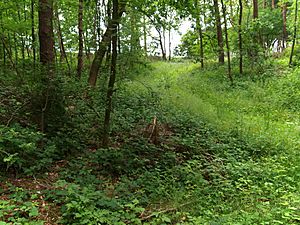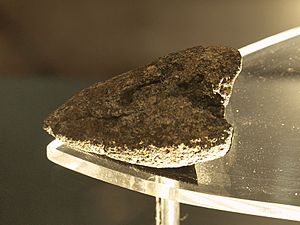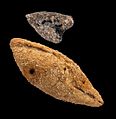Ovelgönne bread roll facts for kids
The Ovelgönne bread roll is a very old piece of bread. It was found in 1952 in a clay pit in Ovelgönne, Germany. This special bread roll comes from the Pre-Roman Iron Age of Northern Europe, a time long before the Roman Empire. It is the oldest shaped bread product ever found in Europe! You can see the original bread and a recreated version at the Archaeological Museum Hamburg.
Contents
Where the Bread Was Found
In May 1952, an expert named Willi Rühland was exploring a clay pit in Ovelgönne. He noticed a dark spot in the clay wall. This spot was an old pit, about 150 centimeters (60 inches) deep and 150 centimeters (60 inches) wide.
The pit was filled with interesting things. There were pieces of pottery, bits of charcoal, and stones. This mix suggested it was an Iron Age rubbish pit. About halfway down, the team found the charred (burnt) remains of the bread roll.
What the Bread Looked Like
The Ovelgönne bread roll originally had two pointed ends. It was a "formed" bakery product, meaning it was shaped on purpose. The piece found was only about half of the original roll.
The part that survived is quite small. It is about 35 millimeters (1.4 inches) long, 22.94 millimeters (0.9 inches) wide, and 11.44 millimeters (0.45 inches) high. It weighs only 2.5 grams (0.09 ounces)! The very tip of the remaining end is missing.
Details of the Roll
The bread's surface is a pearl grey to slate grey color. Its underside is grey to black. On top, there is a fine, slightly curved cut. This cut was probably made to stop the bread from tearing while it baked.
Near the middle of the top surface, there is a small dent. It is 2 millimeters (0.08 inches) deep. This dent was made by pressing a round tool into the dough at an angle. The original bread likely had another similar hole on its missing half.
How It Was Made
The bread did not have a hard crust. It was made from very finely ground and sifted wheat flour. Scientists looked at the surface under a microscope. They found tiny marks from fine millstones.
The dough was kneaded very well. It had very few small holes, which suggests that no yeast or sourdough was used to make it rise. Perhaps protein or fat was added to make the dough lighter.
The bread was baked in an oven on a stone surface. This surface was mostly clean, but a few small bits of charcoal stuck to the bottom of the bread. The bread was baked with very high heat from the top, much hotter than we bake bread today.
What Happened to It
Sandy bits inside the broken surface show that the bread broke apart before it was found. Scientists in Switzerland used X-rays to study the bread. The X-rays showed that the cut on top widened slightly inside. They also found two tiny, mysterious metal pieces inside the dough!
An expert named Max Währen studied many old bread finds. He figured out the original size of the Ovelgönne bread roll. He estimated it was about 70 millimeters (2.8 inches) long, 45.88 millimeters (1.8 inches) wide, and 22.48 millimeters (0.9 inches) high. This takes into account that the bread shrunk about 15% when it was charred.
Scientists used the pottery shards found with the bread to figure out its age. They dated the Ovelgönne bread roll to the early Iron Age, around 800 to 500 B.C.
Images for kids







